
Here you can study for the exam. Look up keywords and learn definitions about all kind of subjects.
More subjects
Qabeli palaw (Dari: قابلی پلو, pronounced [qɒːbeliː palaw]) is a variety of pilaf made in Afghanistan. It consists of steamed rice mixed with raisins, carrots, and beef or lamb. There exists different variations depending on the region. Qabeli palaw is considered a festive and important dish due to the price and quality of the ingredients as well as its tradition of being Afghanistan's national dish. The dish is traditionally placed in the center of the meal with other foods making up the rest of the perimeter. (Source: Wikipedia.org, CC BY-SA)
 © Wikimedia.org/ Jost Wagner, CC BY-SA
© Wikimedia.org/ Jost Wagner, CC BY-SA
Tavë kosi (soured milk casserole) is a national dish in Albania. It is a dish of lamb (occasionally chicken, then called tavë kosi me mish pule) and rice baked with a mixture of yogurt and eggs (replacing the original soured milk) added to a roux (wheat flour and butter). It is also popular in Greece, North Macedonia, Kosovo and Turkey, where it is known as Elbasan tava (Albanian: Tavë Elbasani or Tava e Elbasanit), named after the Albanian city of Elbasan. (Source: Wikipedia.org, CC BY-SA)
Couscous (Arabic: كُسْكُس kuskus; Berber languages: ⵙⴽⵙⵓ, romanized: seksu) – sometimes called kusksi or kseksu – is a traditional North African dish of small steamed granules of rolled semolina that is often served with a stew spooned on top. Pearl millet, sorghum, bulgur, and other cereals are sometimes cooked in a similar way in other regions, and the resulting dishes are also sometimes called couscous.: 18 Couscous is a staple food throughout the Maghrebi cuisines of Algeria, Tunisia, Mauritania, Morocco, and Libya.: 250 It was integrated into French and European cuisine at the beginning of the twentieth century, through the French colonial empire and the Pieds-Noirs of Algeria. (Source: Wikipedia.org, CC BY-SA)
 © Wikimedia.org/Nasimanilsen25, CC BY-SA
© Wikimedia.org/Nasimanilsen25, CC BY-SA
Escudella i carn d'olla, or shorter escudella, (Eastern Catalan: [əskuˈðeʎə]; lit. 'bowl') is a traditional Catalan and Valencian meat and vegetable stew and soup. Francesc Eiximenis wrote in the 14th century that it was eaten every day by Catalan people. It is characterized by the use of a pilota, a very big meatball spiced with garlic and parsley; it also contains vegetables as celery, cabbage, carrots, etc. depending on the season. Additionally, bones, sausages called botifarra, and other types of meat, can be used. In historical times a type called escudella de pagès, which had pasta and rice, was traditionally made on Thursdays and Sundays. (Source: Wikipedia.org, CC BY-SA)
Moambe chicken (French: poulet à la moambe or simply poulet moambe, Portuguese: moamba de galinha) is a savory chicken dish popular in Central Africa and considered the national dish of Angola. The dish itself is made by combining chicken, spices and palm butter to create a stew-like consistency. A number of local or regional variations exist across the Congo and Central Africa; the dish is also known outside the continent. Poulet moambe (French for 'chicken in palm butter sauce') is prepared by cooking chicken in moambe (palm butter) and spinach, then seasoned with spices like peri-peri or red pepper. It is typically served with sweet potatoes, brown onions, hard-boiled eggs and a sauce made from crushed palm nuts. Moambe chicken can also be accompanied by rice or manioc (cassava) paste. The chicken can be substituted with duck or fish. (Source: Wikipedia.org, CC BY-SA)
Asado (Spanish: [aˈsaðo]) is the technique and the social event of having or attending a barbecue in various South American countries, especially Argentina, Chile, Paraguay and Uruguay where it is also a traditional event. An asado usually consists of beef, pork, chicken, chorizo, and morcilla, all of which are cooked using an open fire or a grill, called a parrilla. Usually, red wine and side dishes such as salads accompany the main meats, which are prepared by a designated cook called the asador or parrillero. Usually the asador begins by igniting the charcoal, which is often made of native trees, avoiding pines and eucalyptus as they have strong-smelling resins. In more sophisticated asados the charcoal is of a specific tree or made on the coal of recently burned wood, which is also commonplace when having an asado in a campfire. In Uruguay, charcoal is not used, but instead direct embers or hot coals. (Source: Wikipedia.org, CC BY-SA)
An empanada is a type of baked or fried turnover consisting of pastry and filling, common in Spanish, other Southern European, Latin American, and Iberian-influenced cultures around the world. The name comes from the Spanish empanar (to bread, i.e., to coat with bread), and translates as 'breaded', that is, wrapped or coated in bread. They are made by folding dough over a filling, which may consist of meat, cheese, tomato, corn, or other ingredients, and then cooking the resulting turnover, either by baking or frying. (Source: Wikipedia.org, CC BY-SA)
Locro (from the Quechua ruqru) is a hearty thick squash stew, associated with Native Andean civilizations, and popular along the Andes mountain range. It is one of the national dishes of Peru, Bolivia, Ecuador, Chile, Paraguay, Northwest Argentina and Southwestern Colombia. The dish is a classic squash, corn, beans, and potato or pumpkin soup well known along the South American Andes. In some regions locro is made using a specific kind of potato called 'papa chola', which has a unique taste and is difficult to find outside of its home region. The defining ingredients are squash, corn, some form of meat (usually beef, but sometimes beef jerky or chorizo), and vegetables. Other ingredients vary widely, and typically include onion, beans, squash or pumpkin. It is mainly eaten in winter. (Source: Wikipedia.org, CC BY-SA)
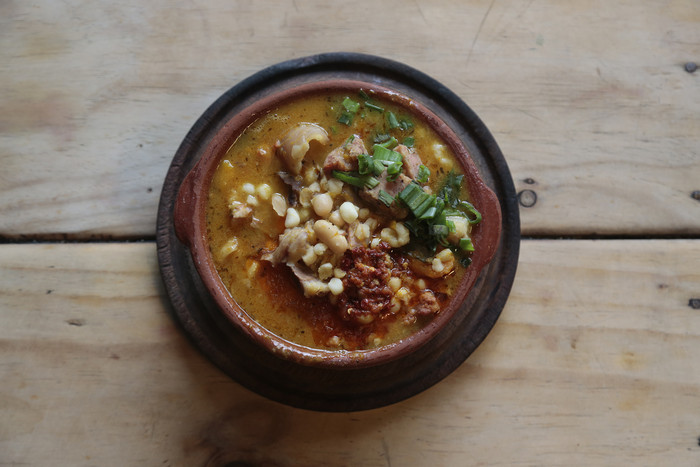 © Wikimedia.org/Matías Repetto, CC BY-AR
© Wikimedia.org/Matías Repetto, CC BY-AR
Matambre is the name of a very thin cut of beef in Argentina, Uruguay and also Paraguay. It is a rose colored muscle taken between the skin and the ribs of the steer, a sort of flank steak. It is not the cut known normally in the U.S. as flank steak. Some people refer to it as the 'fly shaker', because it is the muscle used by the animal to twitch to repel flies and other flying insects. Matambre is cut from the side of the cow, between the skin and the ribs. The scientific name for the muscle is cutaneous trunci. It is a thin rose colored muscle, also known in packing houses as 'fly shaker' or 'elephant ear'. It is also known as the 'twitch' muscle because the animal makes it twitch or tremble to repel flying insects like flies. It is very thin and lends itself for rolling up with different stuffings. (Source: Wikipedia.org, CC BY-SA)
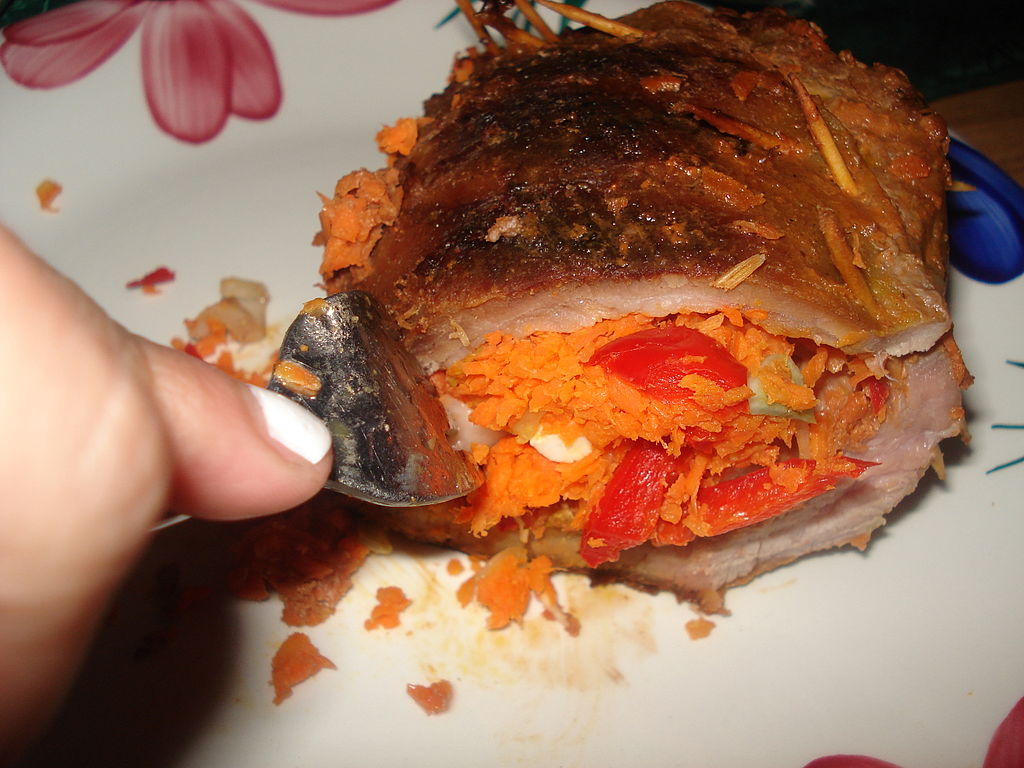 © Wikimedia.org/Gesellman, CC BY
© Wikimedia.org/Gesellman, CC BY
Harees, jareesh (Arabic: هريس), boko boko, or harisa (Armenian: հարիսա, romanized: harisa) is a dish of boiled, cracked, or coarsely-ground wheat, mixed with meat and seasoned. Its consistency varies between a porridge and a gruel. Harees is a popular dish known throughout the Arab world, and is commonly eaten in Arab states of the Persian Gulf in the month of Ramadan, and in Iraq, Lebanon and Bahrain during Ashura by Shia Muslims. The wheat is soaked overnight, then simmered in water along with meat and butter or sheep tail fat. Any remaining liquid is strained and the mixture is beaten and seasoned. Harees may be garnished with cinnamon, sugar, and clarified butter. (Source: Wikipedia.org, CC BY-SA)
Khorovats (Armenian: խորոված, [χoɾoˈvɑt͡s]) is an Armenian barbecue. The meat may be marinated before grilling, but it does not have to be. It can be made with lamb, pork, beef, chicken, fish, or even veal. This is generally a dish reserved for 'festive occasions'. Khorovats can be made with lamb, pork, beef, chicken, or less commonly veal. Some type of vegetable is usually served with the meat. A common preparation for green vegetables like asparagus or green beans is to fry them and combine with whipped eggs, a dish which resembles scrambled eggs with vegetables. (Source: Wikipedia.org, CC BY-SA)
A meat pie is a pie with a filling of meat and often with other savory ingredients. They are found in cuisines worldwide. Meat pies are usually baked, fried, or deep fried to brown them and develop the flavour through the Maillard reaction. Many varieties have a flaky crust. The origins of the meat pie have been traced back to the Neolithic period, around 9500 BC. Versions of what are now known as pies were featured on ancient Egyptian tomb walls, and in ancient Greek and Roman texts. (Source: Wikipedia.org, CC BY-SA)
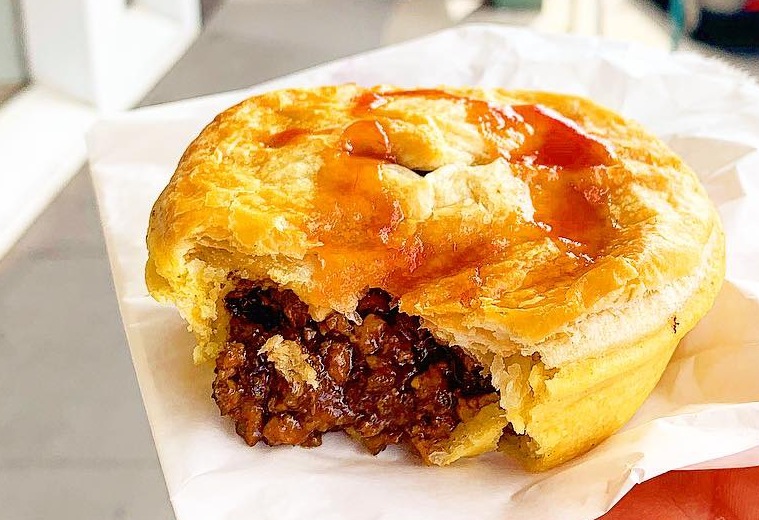 © Wikimedia.org/Finbar.concaig, CC BY-SA
© Wikimedia.org/Finbar.concaig, CC BY-SA
Pavlova is a meringue-based dessert. Originating in either Australia or New Zealand in the early 20th century, it was named after the Russian ballerina Anna Pavlova. Taking the form of a cake-like circular block of baked meringue, pavlova has a crisp crust and soft, light inside. The confection is usually topped with fruit and whipped cream. The name is commonly pronounced /pævˈloʊvə/ pav-LOH-və or (in North America) /pɑːvˈloʊvə/ pahv-LOH-və, and occasionally closer to the name of the dancer, as /ˈpɑːvləvə/ PAHV-lə-və. The dessert is believed to have been created in honour of the dancer either during or after one of her tours to Australia and New Zealand in the 1920s. The nationality of its creator has been a source of argument between the two nations for many years. The dessert is a popular dish and an important part of the national cuisine of both Australia and New Zealand. With its simple recipe, it is frequently served during celebratory and holiday meals. It is most identified with and consumed most frequently in the summer time, including at Christmas time. (Source: Wikipedia.org, CC BY-SA)
 © Wikimedia.org/Hazel Fowler, CC0
© Wikimedia.org/Hazel Fowler, CC0
Lamb, hogget, and mutton, generically sheep meat, are the meat of domestic sheep, Ovis aries. A sheep in its first year is a lamb and its meat is also lamb. The meat from sheep in their second year is hogget. Older sheep meat is mutton. Generally, 'hogget' and 'sheep meat' are not used by consumers outside Norway, New Zealand, South Africa, Scotland, and Australia. Hogget has become more common in England, particularly in the North (Lancashire and Yorkshire) often in association with rare breed and organic farming. (Source: Wikipedia.org, CC BY-SA)
Wiener schnitzel (/ˈviːnər ˈʃnɪtsəl/ VEE-nər SHNIT-səl; German: Wiener Schnitzel [ˈviːnɐ ˈʃnɪtsl̩] , 'Viennese cutlet'), sometimes spelled Wienerschnitzel, is a type of schnitzel made of a thin, breaded, pan-fried veal cutlet. It is one of the best known specialities of Viennese cuisine, and one of the national dishes of Austria. The dish is prepared from veal slices, butterfly cut, about 4 mm (3⁄16 in) in thickness and lightly pounded flat, slightly salted, and rolled in flour, whipped eggs, and bread crumbs. The bread crumbs must not be pressed into the meat, so that they stay dry and can be 'souffléd'. Finally the Schnitzel is fried in a good proportion of lard or clarified butter at a temperature of 160–170 °C (320–340 °F) until it is golden yellow. The Schnitzel must swim in the fat, otherwise it will not cook evenly: the fat cools too much and intrudes into the bread crumbs, moistening them. During the frying the Schnitzel is repeatedly slightly tossed around the pan. Also during the frying, fat can be scooped from the pan with a spoon and poured onto the meat. The Schnitzel is cooked after it turns golden yellow or brown. (Source: Wikipedia.org, CC BY-SA)
Dolma (Turkish for 'stuffed') is a family of stuffed dishes associated with Ottoman cuisine, typically made with a filling of rice, minced meat, offal, seafood, fruit, or any combination of these inside a vegetable or a leaf wrapping. Wrapped dolma, specifically, are known as sarma, made by rolling grape, cabbage, or other leaves around the filling. Dolma can be served warm or at room temperature and are common in modern cuisines of regions and nations that once were part of the Ottoman Empire. (Source: Wikipedia.org, CC BY-SA)
 © Wikimedia.org/Violetamyftari, CC BY-SA
© Wikimedia.org/Violetamyftari, CC BY-SA
Conch (/kɒŋk, kɒntʃ/) is a common name of a number of different medium-to-large-sized sea snails. Conch shells typically have a high spire and a noticeable siphonal canal (in other words, the shell comes to a noticeable point at both ends). In North America, a conch is often identified as a queen conch, indigenous to the waters of the Gulf of Mexico and Caribbean. Queen conches are valued for seafood and are also used as fish bait. In the United States, a rule has been proposed to list the queen conch's conservation status as threatened. (Source: Wikipedia.org, CC BY-SA)
Rice and peas (or peas and rice) is a traditional food within the West Indian Caribbean islands. The 'peas' are traditionally pigeon peas, but more often substituted with kidney beans, and the dish is frequently served with curry goat. Rice and peas is the mainstay of the cuisines of The Bahamas, Jamaica, Barbados, Haiti and many other English-speaking Caribbean islands. In The Bahamas, it is known as peas n' rice, from which the Bahamian folk song 'Mamma don't want no Peas n' Rice and Coconut Oil' is named. The dish is made with rice and any available legume, such as kidney beans, pigeon peas (known as gungo peas), or cowpeas, the combination of grain and a legume forming a complete protein; compare rice and beans. Gungo peas are particularly associated with Christmas. The peas are boiled with pimenta seeds and garlic until tender. Scotch bonnet pepper, thyme, scallions and/or round onions, grated ginger and coconut milk are then added along with the rice and left to simmer until cooked. (Source: Wikipedia.org, CC BY-SA)
Kabsa (Arabic: كبسة kabsah) or makbūs/machbūs (مكبوس/مچبوس Gulf pron.: [mɑtʃˈbuːs]) is an Arab mixed rice dish that originates from Yemen. It is commonly regarded as a national dish in all the countries of the Arabian Peninsula. It can also be found in regions such as southern Iran, Gaza in Palestine, and the Malabar Coast of India. These dishes are usually made with rice (usually basmati), meat, vegetables, and a mixture of spices. There are many kinds of kabsa and each kind has a uniqueness about it. (Source: Wikipedia.org, CC BY-SA)
The ilish (Tenualosa ilisha) (Bengali: ইলিশ, romanized: iliś; also known as the ilishi, hilsa, hilsa herring or hilsa shad, is a species of fish related to the herring, in the family Clupeidae. It is a very popular and sought-after food fish in the Indian Subcontinent, and is the national fish of Bangladesh and the state fish of West Bengal. The most famous hilsha fish comes from Chandpur, Bangladesh. The fish contributes about 12% of the total fish production and about 1.15% of GDP in Bangladesh. On 6 August 2017, Department of Patents, Designs and Trademarks under the Ministry of Industries of Bangladesh has declared the recognition of ilish as the product of Bangladesh. As of 2021, 86% of the world's total ilish supply originates in Bangladesh which applied for Geographical indication (GI) in 2004. About 450,000 people are directly involved in the catching of the fish as a large part of their livelihood; around four to five million people are indirectly involved with the trade. (Source: Wikipedia.org, CC BY-SA)
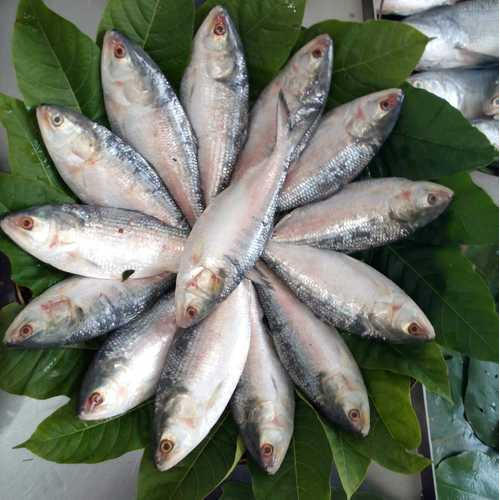 © Wikimedia.org/Roddur 123, CC BY
© Wikimedia.org/Roddur 123, CC BY
Cou-cou, coo-coo (as it is known in the Windward Islands), or fungie (as it is known in the Leeward Islands and Dominica) makes up part of the national dishes of Antigua and Barbuda, Barbados, British Virgin Islands and the U.S. Virgin Islands. It consists mainly of cornmeal (corn flour) and okra (ochroes). Cornmeal, which comes readily packaged and is available at supermarkets islandwide, and okra, which can be found at supermarkets, vegetable markets and home gardens, are very inexpensive ingredients. Because these main components are inexpensive, the dish became common for many residents in Barbados' early colonial history. In Ghana, a similar meal of fermented corn or maize flour eaten with okra stew and fish is known as banku, a favourite dish of the Ga tribe in Accra. (Source: Wikipedia.org, CC BY-SA)
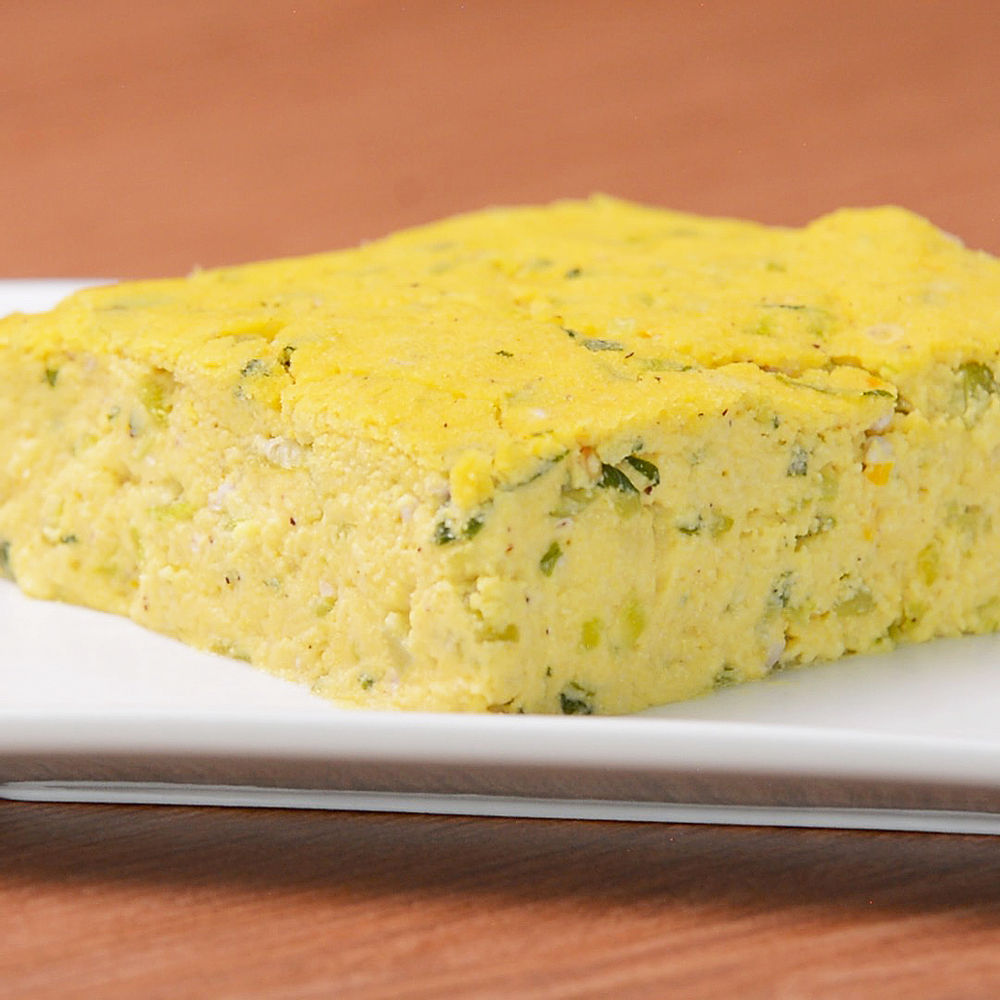 © Wikimedia.org/KINGBROBLOXZZZ, CC BY-SA
© Wikimedia.org/KINGBROBLOXZZZ, CC BY-SA
Potato pancakes are shallow-fried pancakes of grated or ground potato, matzo meal or flour and a binding ingredient such as egg or applesauce, often flavored with grated garlic or onion and seasoning. They may be topped with a variety of condiments, ranging from the savory (such as sour cream or cottage cheese), to the sweet (such as apple sauce or sugar), or they may be served plain. The dish is sometimes made from mashed potatoes to make pancake-shaped croquettes. Some variations are made with sweet potatoes. (Source: Wikipedia.org, CC BY-SA)
Belgian chocolate (French: chocolat belge, Dutch: Belgische chocolade) is chocolate produced in Belgium. A major industry since the 19th century, today it forms an important part of the nation's economy and culture. The raw materials used in chocolate production do not originate in Belgium; most cocoa is produced in Africa, Central America, and South America. Nonetheless, the country has an association with the product that dates to the early 17th century. The industry expanded massively in the 19th century, gaining an international reputation and, together with the Swiss, Belgium became one of the commodity's most important producers in Europe. Although the industry has been regulated by law since 1894, there is no universal standard for the chocolate to be labelled 'Belgian'. The most commonly accepted standard dictates that the actual production of the chocolate must take place inside Belgium. (Source: Wikipedia.org, CC BY-SA)
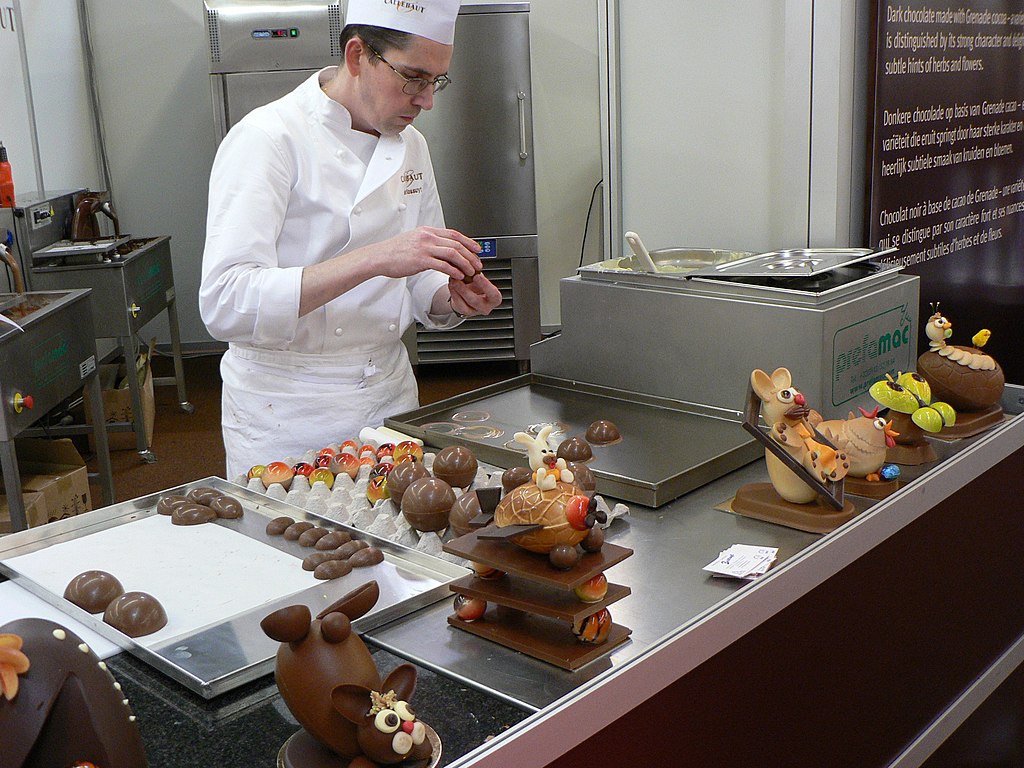 © Wikimedia.org/Oriel, CC0
© Wikimedia.org/Oriel, CC0
Flemish stew, known in Dutch as stoofvlees or stoverij and in French as carbon(n)ade à la flamande is a Flemish beef (or pork) and onion stew popular in Belgium, the Netherlands and French Flanders, made with beer and mustard spread on bread, seasoning can include bay leaf, thyme, clove and juniper berries. In French, a carbon(n)ade may also be a dish of grilled horse loin and certain beef stews cooked with red wine such as beef bourguignon in the east of France. but in English, carbonnade is generally the Belgian dish. The term Flemish stew, being a generic term, is sometimes used to refer to other Flemish dishes such as waterzooi or hochepot. (Source: Wikipedia.org, CC BY-SA)
Moules-frites or moules et frites (French pronunciation: [mul.fʁit]]; Dutch: mosselen-friet) is a main dish of mussels and French fries originating in Belgium. The title of the dish is French, moules meaning mussels and frites fries, with the Dutch name for the dish meaning the same. It is considered the national dish of Belgium. Although moules-frites are popular in many countries, it is thought that the dish originated in Belgium. It is likely that it was originally created by combining mussels, a popular and cheap foodstuff eaten around the Flemish coast, and fried potatoes, which were commonly eaten around the country in winter when no fish or other food was available. (Source: Wikipedia.org, CC BY-SA)
Steak frites, meaning 'steak [and] fries' in French, is a dish consisting of steak paired with French fries. It is commonly served in European brasseries, and is considered by some to be the national dish of Belgium, which claims to be the place of its invention. Historically, the rump steak was commonly used for this dish. More typically at the present time, the steak is an entrecôte also called rib eye, or scotch fillet (in Australia), pan-fried rare ('saignant'—literally 'bloody'), in a pan reduction sauce, sometimes with hollandaise or béarnaise sauce, served with deep-fried potatoes (French fries). Francophilia led to its generalization to the Portuguese-speaking world, where it is called bife e [batatas] fritas or bife com batata frita, especially in Brazil, where the sauce is usually just onion rings cooked and fried in the steak's own juice and frying oil, being the most popular dish to go aside rice and beans. (Source: Wikipedia.org, CC BY-SA)
Waterzooi is a stew dish from Belgium and originating in Flanders. The second part of the name derives from the Middle Dutch terms sode, zo(o)de and soot, words referring to the act of boiling or the ingredients being boiled. It is sometimes called Gentse Waterzooi which refers to the Belgian town of Ghent where it originated. The original dish is often made of fish, either freshwater or sea, (known as Viszooitje), though today chicken waterzooi (Kippenwaterzooi) is more common. The most accepted theory is that rivers around Ghent became too polluted and the fish there disappeared. Charles V, Holy Roman Emperor ate the rich dish, even after suffering from gout. (Source: Wikipedia.org, CC BY-SA)
Ema datshi (Dzongkha: ཨེ་མ་དར་ཚིལ་; Wylie: e-ma dar-tshil) is among the most famous dishes in Bhutanese cuisine, recognized as a national dish of Bhutan. It is made from hot chili peppers and cheese; 'ema' means 'chili' and 'datshi' means 'cheese' in the Dzongkha language of Bhutan. Different varieties of chilies may be used: green chili, red chili, or white chili (green chili washed in hot water and sun-dried), which may be dried or fresh. The chilies are called 'sha ema' which is a Capsicum annuum cultivar, a form of pepper much like cayenne, poblano, ancho, or Anaheim. The cheese used in ema datshi is called Datshi, it is homemade from the curd of cow or yak's milk. In the process, the fat is removed from the curd to make butter, and the remaining curd without fat is used to make the cheese. After the cheese is made, the whey is left over, which is used as a soup that can be taken with rice. No part of the milk is wasted. (Source: Wikipedia.org, CC BY-SA)
A salteña is a type of baked empanada from Bolivia. Salteñas are savory pastries filled with beef, pork or chicken mixed in a sweet, slightly spicy sauce containing olives, raisins and potatoes. Vegetarian salteñas are sometimes available at certain restaurants. Typically salteñas can be found in any town or city throughout the country, but each area has its variations; Cochabamba and Sucre claim to have the best version of this snack, and many will go out of their way to try the variation from Potosí. In La Paz, it is a tradition to enjoy salteñas as a mid-morning snack, although vendors often start selling salteñas very early in the morning. The pastries are sold anywhere from 7am to noon; most vendors sell out by mid-morning. (Source: Wikipedia.org, CC BY-SA)
Ćevapi (Cyrillic: ћевапи, pronounced [tɕeʋǎːpi]), ćevapčići (formal: diminutive; Cyrillic: ћевапчићи, pronounced [tɕeʋǎptʃitɕi]) is a grilled dish of minced meat found traditionally in the countries of southeast Europe (the Balkans). It is considered a national dish of Bosnia and Herzegovina and Serbia and is also common in Croatia, Montenegro, Kosovo, North Macedonia, Slovenia, Bulgaria, Romania, Albania and Austria. They are usually served in groups of five to ten pieces on a plate or in a flatbread (lepina or somun), often with chopped onions, sour cream, kajmak (milk cream), ajvar (relish), and salt. Bosnian ćevapi are made from two types of minced beef meat, hand-mixed and formed with a funnel, while formed ćevapi are grilled. Serbian ćevapčići are made of beef, lamb or pork, or a mixture. (Source: Wikipedia.org, CC BY-SA)
Seswaa (as the dish is called in the north of Botswana) or loswao (as the dish is called in the south of the country and western South Africa) is a traditional meat dish of Botswana, made of beef or goat meat. It is prepared using leftover cuts or tough cuts such as legs, neck and back. The dish is normally prepared for ceremonies such as funerals, weddings and national events such as independence celebrations. The meat is boiled until tender in a pot, with 'just enough salt', and pounded. It is often served with pap (maize meal), setampa (samp, ground corn) or mabele (sorghum). (Source: Wikipedia.org, CC BY-SA)
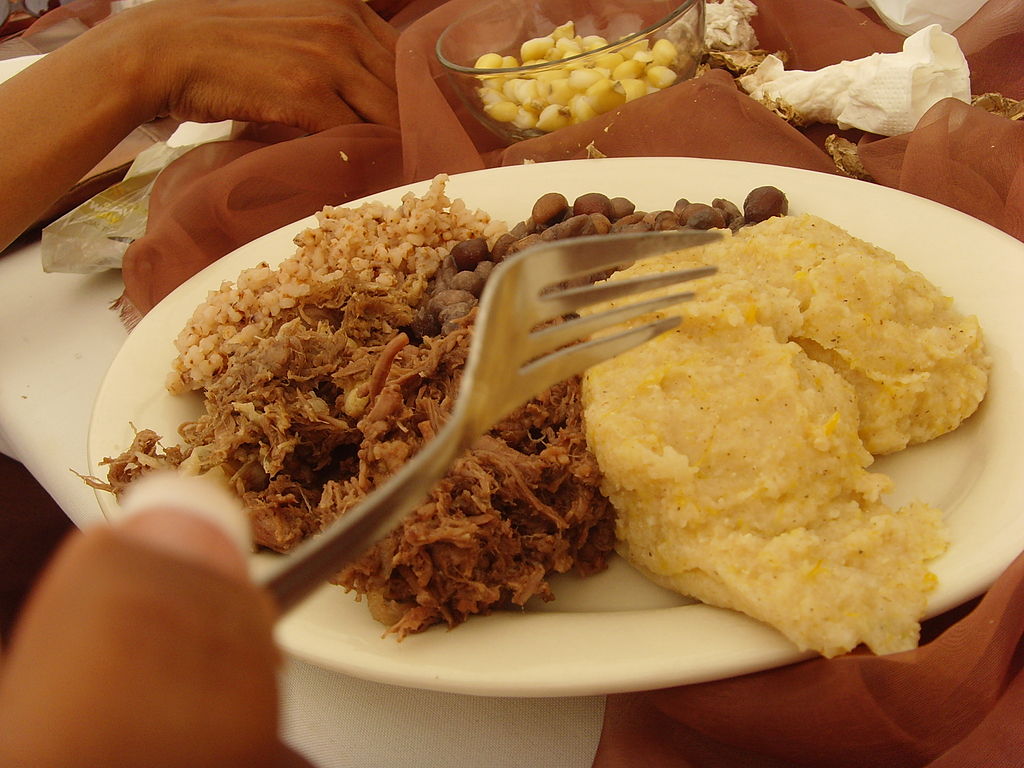 © Wikimedia.org/Kalanga, CC BY-SA
© Wikimedia.org/Kalanga, CC BY-SA
Feijoada (Portuguese pronunciation: [fejʒuˈadɐ]) is a stew of beans with beef and pork. The name feijoada comes from feijão, 'bean' in Portuguese. It is widely prepared in the Portuguese-speaking world, with slight variations. The basic ingredients of feijoada are beans and fresh pork or beef. In Brazil, it is usually made with black beans. The stew is best prepared over low heat in a thick clay pot. It is usually served with rice and assorted sausages such as chouriço, morcela (blood sausage), farinheira, and others, which may or may not be cooked in the stew. Many modern variants of the dish are based on feijoada recipes popularized in the Brazilian regions of Rio de Janeiro, São Paulo, Recife, and Salvador. In Brazil, feijoada is considered a national dish. (Source: Wikipedia.org, CC BY-SA)
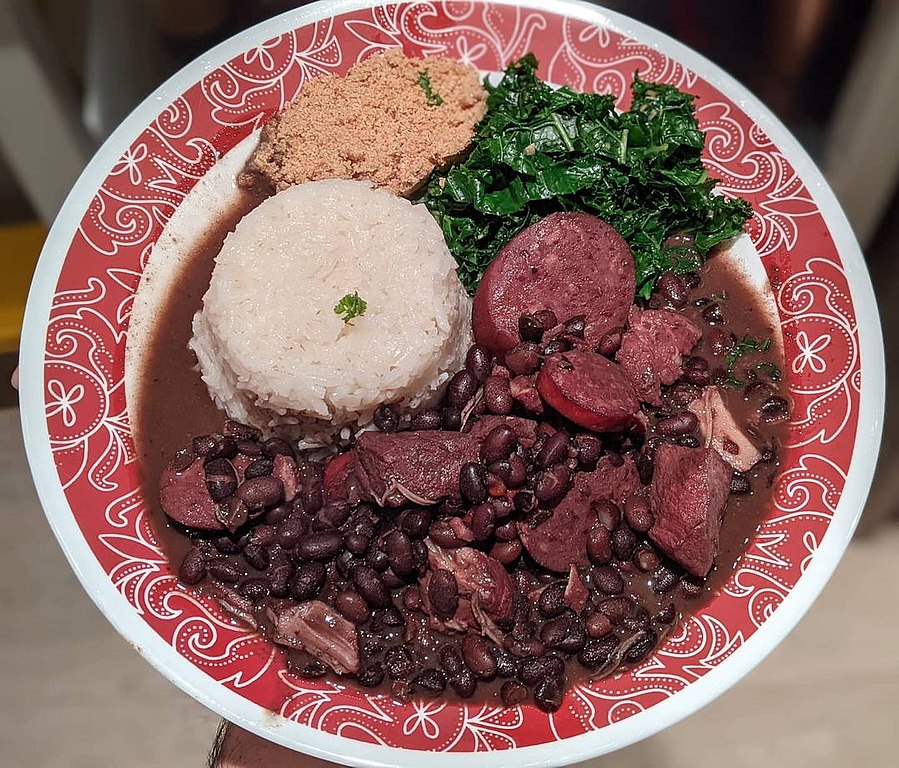 © Wikimedia.org/Bradleyzm, CC BY-SA
© Wikimedia.org/Bradleyzm, CC BY-SA
Ambuyat is a dish derived from the interior trunk of the sago palm. It is a starchy bland substance, similar to tapioca starch. Ambuyat is the national dish of Brunei, and a local specialty in the Malaysian states of Sarawak, Sabah, and the federal territory of Labuan, where it is sometimes known as linut.Ambuyat is eaten with a bamboo chopstick called chandas, by rolling the starch around the prongs and then dipping it into a sauce, of which there are many varieties, including tempoyak. There is a similar dish in eastern Indonesia called papeda. It has a glutinous texture and is chewy. (Source: Wikipedia.org, CC BY-SA)
Banitsa (Bulgarian & Macedonian: баница), also transliterated as banica and banitza, is a traditional pastry dish made in Bulgaria, North Macedonia and Southeastern Serbia (where it may also be referred to as gibanica), prepared by layering a mixture of whisked eggs, natural yogurt and pieces of white brined cheese between filo pastry and then baking it in an oven. Traditionally, lucky charms are put into the pastry on certain occasions, particularly on New Year's Eve. These charms may be coins or small symbolic objects (e.g., a small piece of a dogwood branch with a bud, symbolizing health or longevity). More recently, people have started writing happy wishes on small pieces of paper and wrapping them in tin foil. Wishes may include happiness, health, or success throughout the new year (similar to fortune cookies). (Source: Wikipedia.org, CC BY-SA)
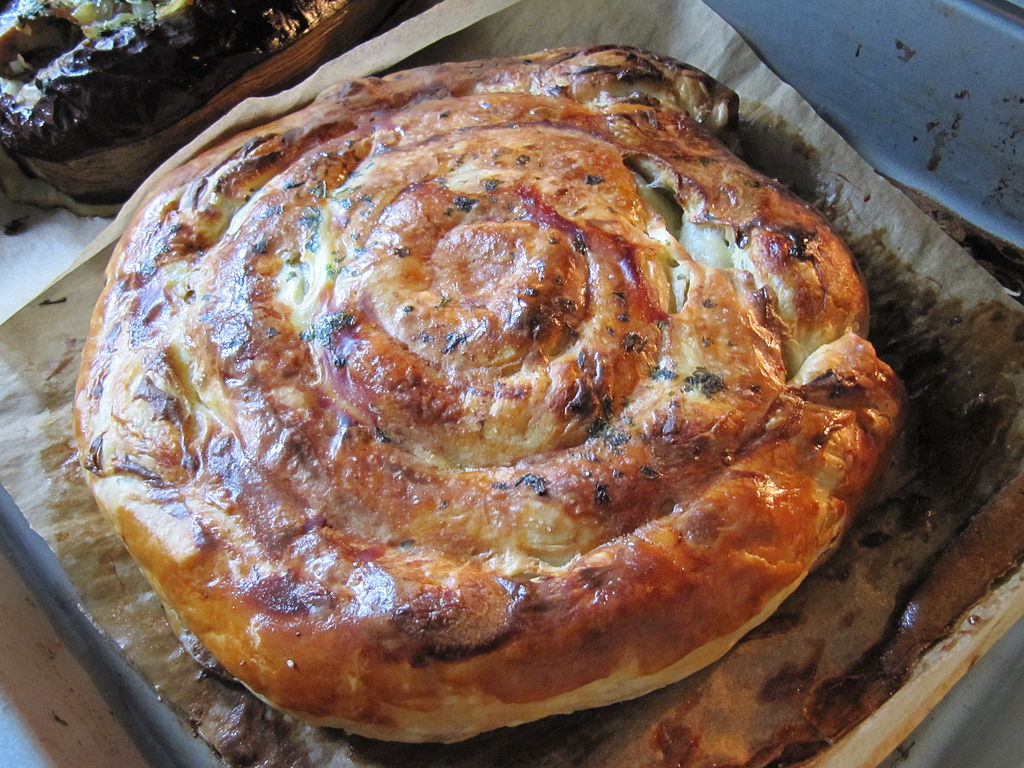 © Wikimedia.org/borzo, CC BY-SA
© Wikimedia.org/borzo, CC BY-SA
Shopska salad (Bulgarian, Macedonian and Serbian: Шопска салата; Croatian: Šopska salata; Romanian: Salata bulgărească; Czech: Šopský salát; Polish: Sałatka szopska; Albanian: Sallatë Shope; Hungarian: Sopszka saláta; Greek: Σαλάτα σόπσκα) is a cold salad popular throughout Southeastern Europe. This is Bulgaria's most famous salad and national dish, whose colors recall the Bulgarian flag. It is made from tomatoes, cucumbers, onion/scallions, raw or roasted peppers, sirene (white brine cheese), and parsley. The vegetables are usually diced and salted, followed by a light dressing of sunflower oil (or olive oil, which is less authentic), which is occasionally complemented by vinegar. The addition of vinegar contributes, however, to the sour flavour that the tomatoes impart. In restaurants, the dressings are provided separately. Lastly, the vegetables are covered in a thick layer of grated or diced sirene cheese. This salad is often consumed as an appetizer with rakia. (Source: Wikipedia.org, CC BY-SA)
Fish amok or amok trei (Khmer: អាម៉ុកត្រី [ʔaːmok trəj]) is a Khmer steamed fish curry (amok) with a mousse-like consistency, considered one of Cambodia's national dishes. Fish amok is believed to have been a royal Khmer dish dating back to the Khmer Empire, although others question it originating in Cambodia. Usually, goby fish, snakehead fish or catfish is used, however, they are also sometimes substituted with cod, snapper, barramundi, salmon, whiting, or perch. The fish fillets are rubbed with or marinated in a freshly-made yellow or green kroeung mixed with coconut cream or coconut milk and eggs. The curry mixture is placed in a banana leaf container with great morinda leaves at the bottom and steamed for around 20 to 30 minutes until the curry achieves a mousse-like consistency. Great morinda leaves can also be substituted with Swiss chard leaves if not available. (Source: Wikipedia.org, CC BY-SA)
Samlar kako (Khmer: សម្លកកូរ, lit. 'stirring soup', pronounced [sɑmlɑː kɑːkou]) is a traditional soup dish of Cambodia. It is also considered one of Cambodian's national dishes. Samlar kako consists of green kroeung, prahok, roasted ground rice, catfish, pork or chicken, vegetables, fruits and herbs. Unlike other Khmer dishes, this can be served as a one-pot dish because it is a well-balanced meal on its own. Some prefer it as a vegetarian dish where the fish and meat are omitted and replaced by coconut cream and vegetable stock. (Source: Wikipedia.org, CC BY-SA)
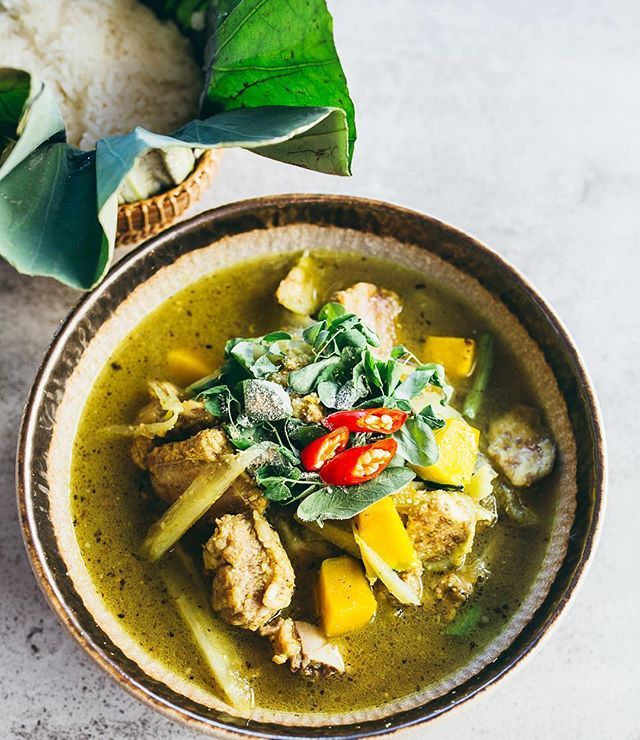 © Wikimedia.org/Louistrinh, CC BY-SA
© Wikimedia.org/Louistrinh, CC BY-SA
Ndolé is a Cameroonian dish consisting of stewed nuts, ndoleh (bitter leaves indigenous to West Africa), and fish or beef. The dish may also contain shrimp. It is traditionally eaten with plantains, bobolo (a Cameroonian dish made of fermented ground manioc or cassava and wrapped in leaves), etc. (Source: Wikipedia.org, CC BY-SA)
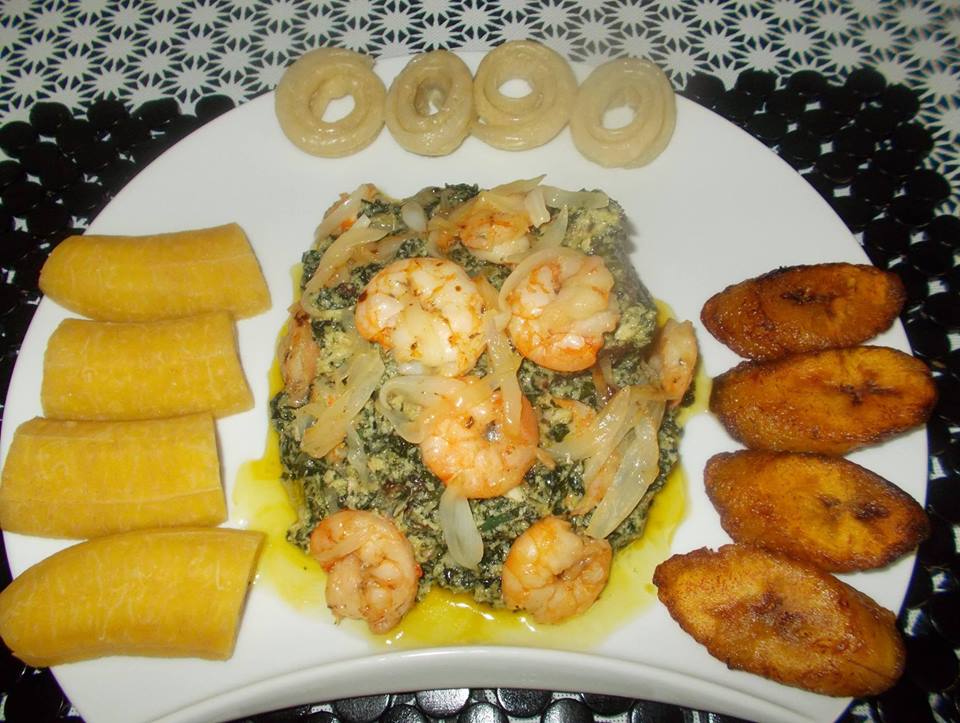 © Wikimedia.org/Coco lago, CC BY-SA
© Wikimedia.org/Coco lago, CC BY-SA
A butter tart (French: tarte au beurre) is a type of small pastry tart highly regarded in Canadian cuisine. The sweet tart consists of a filling of butter, sugar, syrup, and egg, baked in a pastry shell until the filling is semi-solid with a crunchy top. The butter tart should not be confused with butter pie (a savoury pie from the Preston area of Lancashire, England) or with bread and butter pudding. Recipes for the butter tart vary according to the families baking them. Because of this, the appearance and physical characteristics of the butter tart – the firmness of its pastry, or the consistency of its filling – also vary. (Source: Wikipedia.org, CC BY-SA)
The Nanaimo bar /nəˈnaɪmoʊ/ is a bar dessert that requires no baking and is named after the Canadian city of Nanaimo in British Columbia. It consists of three layers: a wafer, nut (walnuts, almonds, or pecans), and coconut crumb base; custard icing in the middle; and a layer of chocolate ganache on top. Many varieties exist, consisting of various types of crumb, various flavours of icing (such as peanut butter or coconut, mocha), and various types of chocolate. (Source: Wikipedia.org, CC BY-SA)
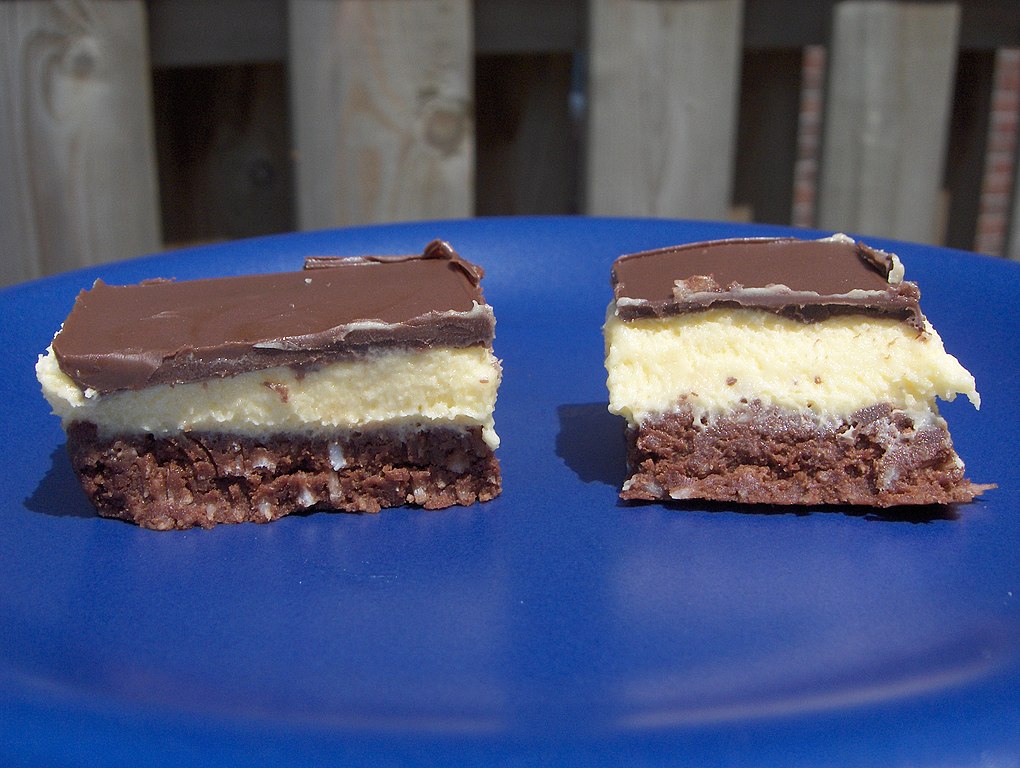 © Wikimedia.org/Stephanie Spencer, CC BY-SA
© Wikimedia.org/Stephanie Spencer, CC BY-SA

Time for recess! Post a comment, ask a question or write a review. Feel free to let us know what you think!
look at the sign on the road to avoid accidents and horrible driving conditions
I received a 300$ ticket because I passed a police control of other cars/drivers on the right lane of a highway (the control was on the hard shoulder of the highway). Is it really true, that you have to change the lane in such cases? Thanks!
I am an American living in Italy. The Italian Drivers License theory test is the hardest test I have ever studied for and I am in my 70s have multiple degrees, multiple professional certifications. Have to take the Italian Drivers Theory test in Italian. No english. So many rules. More signs in small medieval Italian town I live in then in major US cities I have lived in. No Italian license no driving. No buying or renting a car. Test here was good, clean. Lots of tricky questions on many practice and real official tests. Thanks
Most problems are a result of higher than safe driving speeds. Please just slow down and be patient.
Question 121: Poor translation: Vehicles with polluted fluids prohibited Should be translated as: Vehicles with dangerous liquids prohibited
Question 83: Poor translation: Vehicles with polluted fluids prohibited Should be translated as: Vehicles with dangerous liquids prohibited
Want even more practice? Visit similar websites offering realistic practice driving knowledge tests. Visit us to see what sets our tests apart! https://dkttest.com/capital-territory/
Cool tool! And fun to check whether I remember the rules :) Two things I noticed: Warning for a crossroad side roads on the left and right. While technically that might be the correct translation, this sign tells you, that you are on the main road and have the right of way for the next crossroad and only the next crossroad. Usually (if no sign specifies otherwise) you have to give way to drivers coming from the right at every intersection, which can get a bit annoying in communal areas, so seeing this sign feels less like a warning and more like relief :). A Fahrradstraße is not a lane for cyclists but a street for cyclists, meaning the (whole!) street is intended predominantly for cyclists, who are then allowed to ride next to each other. Cars are allowed to drive there (unless another sign prohibits such), but have to adjust their speed to the cyclists. I believe they are not allowed to pass at all, even if the oncoming lane is empty.
More community